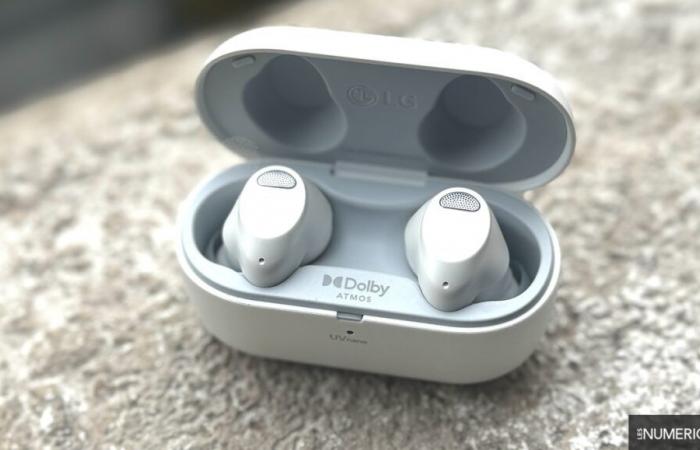Not necessarily the first manufacturer to put down on a sheet of paper when talking about portable audio, LG has nevertheless always tried to be present in this market with its Tone Free range. Its philosophy is very particular, namely to offer innovative products on a technological level.
Cleaning the headphones using ultraviolet rays, a box that serves as a Bluetooth relay or even support for Dolby Atmos with Dolby Head-Tracking: already present on older models of the firm, these original features are obviously still present on the T90S.
In addition to introducing a new design (earphones and case), the T90S aims to do better than their predecessors, particularly in terms of sound thanks to new graphene transducers, but also in terms of noise reduction. An area that has often been LG’s Achilles heel.
Price and availability
The LG Tone Free T90S headphones were made official in France at the end of May 2024 in two colors (black and white), at a launch price of €230.
Test condition
We tested the T90S running firmware version 1.21.1 with the LG Tone Free app running version 1.6.16
Construction & Confort
For these semi-in-ear headphones, LG has completely revised its stylistic proposition. While the previous models in the Tone Free range adopted a design with a stem, like AirPods, the T90S introduce a more compact format.
To accompany this more oval than round shape, a protrusion is present on the bottom of each earpiece. It ensures excellent support by coming to rest just above the antitragus and the lobe. For their part, the cannulas are delicately positioned in the hollow of the conchae. Well helped by discreet dimensions (21.6 x 21.9 x 24.2 mm for 5.7 g), no discomfort or pressure is to be reported, even during long listening sessions.
As for the manufacturing, LG has been relatively serious. The matte plastic is pleasant to the touch and two discreet grilles adorn each earpiece. It is nevertheless a shame that the central assembly trace is not a little more discreet.
Although not intended for intensive sports use, the T90S are IPX4 certified and are therefore resistant to splashes and sprays of water.
Housing
Here too, LG is getting a makeover. While the brand’s previous headphones offered round cases, the T90S fall into line with a more conventional case.
Rectangular in shape, this case is ultra-compact (65 x 29 x 32 mm for 43 g). This is rather appreciable since it can be slipped without taking up too much space in a jeans or shorts pocket. There are also no complaints about the robustness of the case and its hinge. Inaugurated on the Tone+ Free in 2019, UVnano technology is still present on this model. According to LG, 99.9% of bacteria are eliminated on the tips in just 10 minutes. Difficult to verify, this figure at least has the merit of reassuring the most hypochondriacs.
The USB-C port sits on the back of the case, while a switch activating the Bluetooth relay is present on the left. In addition to the USB-C to USB-C charging cable, LG provides a 3.5 mm jack to USB-C cable.
User experience
Orders
Wide enough to avoid mishandling, the touch surfaces are located on the entire external face of each earpiece. Easy to tame and responsive, the controls are carried out by tapping (one, two or three) or a short press, then prolonged.
Apart from this last gesture, all the others are completely customizable, either on the left or the right earbud. An appreciable freedom that will allow everyone to create their favorite gesture choreography. Finally, to facilitate interaction, each gesture is accompanied by a slight noise in the form of a click.
Application
Far from being stingy with features, LG offers everything you would expect from a quality dedicated app. Precise indicators of the autonomy of the earphones and the case, 8-band equalizer, Low latency mode, listening test, location function, management of listening modes, audio presets and Dolby Atmos… It is possible to do just about everything.
We do note a slight lack of ergonomics, however, with the system of tiles that can be opened on a single page making navigation a little confusing at times.
Connectivity
In this area, LG is trying to differentiate itself from the competition by offering several interesting features. The first, already present on the Tone Free FP9 and T90 models, is the ability to make the headphones compatible with any support with a mini-jack output. Very useful, this Bluetooth relay function can provide many services. For example, the user will benefit from wireless listening on the screen of their airplane seat during a long-haul flight.
Another nice touch is the connection possibilities. In addition to multipoint, the LG T90S can sync with up to five devices at the same time. This makes it possible to easily switch between multiple devices without having to go through the pairing box. Everything is managed smoothly in the app from a hub.
In terms of codecs, the Bluetooth 5.2 chip supports the classic AAC and SBC, as well as aptX Adaptive. Fast pairing on Android and Windows (Fast Pair and Swift Pair) are present, as is automatic port detection. Finally, in terms of latency, the T90S behave strangely like the Tone Free FP9. By default, it is 250 ms according to our measurements.
However, a Games mode allows this value to be lowered to around 140 ms. This makes it possible to enjoy your video content without worry, or even play without too many problems on a smartphone. However, latency compensation is not instantaneous. You have to wait a handful of seconds between launching a video and synchronization.
Audio
For its high-end Free Tone T90S headphones, LG introduces 11 mm dynamic drivers that are now made entirely of graphene, and no longer simply covered with this material. For the sound signature, as usual on its audio products, the South Korean has renewed a partnership with Meridian. In addition to digital signal processing, the British Hi-Fi brand was responsible for developing the listening presets offered in the app.
In all, there are five pre-recorded spatialization profiles, as well as two customizable profiles that allow you to adjust the equalization mode yourself. Without touching the equalizer, these “custom” modes are typical of LG and Meridian’s signature, namely an accentuation of the low frequencies, which is combined with a late peak in the treble. On paper, this configuration is tempting, the power of the bass being supposed to be balanced by a form of brilliance in the treble.
In reality, it doesn’t work as well. Of course, the rendering is rather immersive, but the separation of the instruments is not optimal and the extreme bass floats too much compared to the rest. In addition, too abrupt, the rather marked dip in the high-mids/beginning of the treble does not allow an ideal transition. The voices lose their vigor and power, which sometimes makes listening a little muffled. Similarly, despite a desire for airiness, the peak of brilliance around 8 kHz disturbs the sound unity. This is particularly noticeable in classical music.
Apart from Natural mode, most other profiles do not allow you to find more coherence, due to overly strong spatialization. However, be sure to use it preferably with active noise reduction (ANR). Without it, the bass becomes anemic. To have sufficient foundation, the volume must necessarily be increased, which can quickly become tiring.
Compare photos
Membrane reactivity measurement: response to square waves at 50 Hz Membrane reactivity measurement: response to square waves at 500 Hz
It is therefore with the RBA and the Natural mode that the T90S are adorned with their finest finery. Less omnipresent, the low end of the spectrum finally displays a little roundness, without necessarily deafening. Nuances are also more perceptible, which allows certain instruments to no longer have a sloppy rendering. Likewise, the hollow of the high-mids is better controlled; the voices are therefore more intelligible and less projected to the back of the stage. It is regrettable to have so many listening possibilities to ultimately rely on only one configuration. This is all the more true since the precision of the T90S is rather faithful, while the stereo width is honorable.
A final word on Dolby Atmos support with Dolby Head-Tracking. This other technological highlight of the Tone Free T90S allows you to enjoy immersive sound and head tracking up to 24-bit/96 kHz, provided you have a compatible device and content. In fact, on music, the result is mixed, the treble lacks too much detail to give breadth to the soundstage.
With video content, it is much more convincing. Spatialization is simulated very naturally, while head movement tracking is quite successful. Some latency issues are identified, but the experience remains generally pleasant.
Isolation
Never really up to par in this area, LG seems to have revised its copy a little with its Tone Free T90S. A little slow to start, the headphones manage to reach 23 dB of attenuation in the transition between bass and low-mids. Muffled sounds like the rolling of a subway or the noise of an engine are emptied of their substance without disappearing completely. Indeed, the headphones only exceed 20 dB too late to offer a coherent and constant attenuation of the lowest frequencies.
On the attenuation of voices, the headphones are ambivalent. On the one hand, the work done on the high-mids has the merit of not giving up too early, while reaching a peak of 30 dB around 2 kHz. As a result, surrounding conversations, and not too close, are very muffled in the street.
Conversely, a loss of efficiency is noticeable between 400 Hz and 1 kHz, an area where the first harmonics of voices are mainly located. In a open spacethe isolation takes a hit since conversations are often closer and more static. For the highs, unsurprisingly, the non-intrusive tips do not work miracles, but manage to reduce the most aggressive sounds.
Two options for ambient sounds: Listen mode and Conversation mode. Both are unfortunately clearly disappointing in the lowest frequencies. In a busy street, it is difficult to perceive a coherent sound environment, the spatialization is not obvious. Of course, the highs do not drop violently, but a lack of ventilation is noticeable. Conversation mode — which we recommend using — more or less fulfills its function. It is possible to hear the person you are talking to, but not necessarily to have a completely fluid conversation with them.
Points forts
-
Correct sound accuracy.
-
Port confortable.
-
Possibility to use the box as a Bluetooth relay.
-
Good performance on Dolby Atmos content.
Weak points
-
Lack of balance in the bass and high-mids
-
Poorly controlled peak in the treble.
-
Poorly calibrated listening profiles.
-
Active noise reduction and ambient mode are disappointing on low frequencies.
Conclusion
How does the rating work?
Benefiting from a new design (case and headphones), the LG T90S tries to stand out from the crowd by stacking specific features. The most useful and successful are Dolby Atmos and Dolby Head-Tracking, as well as Bluetooth relay. On the audio side, our assessment is more mixed. The T90S are generally precise, but the treatment of high-mids and bass still lacks seriousness.






